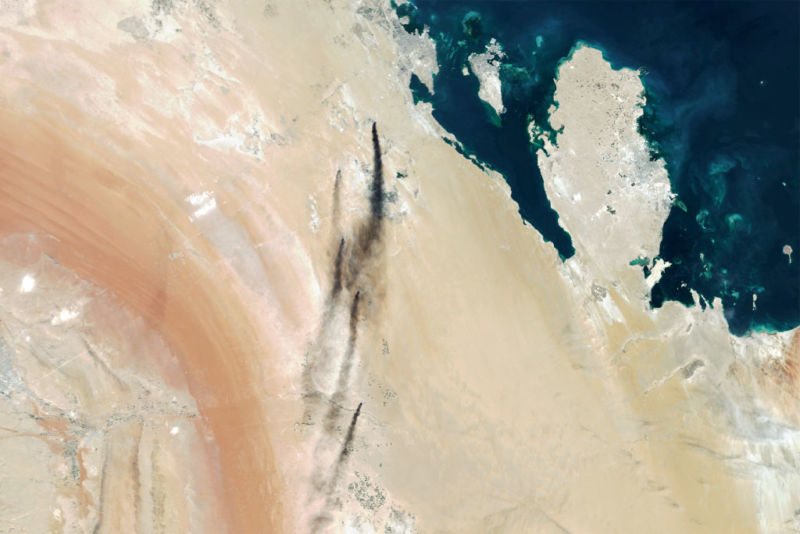Vengeance weapons –
Evidence shows Iran supplied cruise missiles, “loitering munitions” used previously.

Enlarge/Smoke billows from Saudi Aramco’s oil processing plants in Abqaiq and Khurais , Saudi Arabia, after attacks on September 14 – attacks that used drones and possibly cruise missiles built in Iran.
The US government has stopped short of officially blaming Iran for launching drones and cruise missiles against Saudi Arabian oil production facilities. But Secretary of State Mike Pompeo and Secretary of Defense Mark Esper have signaled that Iran is at least complicit in the September 14 strike that took out, at least temporarily, about 5% of global oil production capability. Secretary of State Mike Pompeo came close to directly blaming Iran in a post to Twitter on Saturday:
Tehran is behind nearly 100 attacks on Saudi Arabia while Rouhani and Zarif pretend to engage in diplomacy. Amid all the calls for de-escalation, Iran has now launched an unprecedented attack on the world’s energy supply. There is no evidence the attacks came from Yemen.
– Secretary Pompeo (@SecPompeo)September 14, 2019
While the mix of weapons involved and where they came from is still in dispute, this would hardly be the first time the Houthi ” anti-Saudi resistance militia “used cruise missiles or drones for an attack on Saudi civilian targets. For the last four years, the Houthi forces in Yemen have used a mixture of missiles and drones seized from the Yemeni military and — based on forensic evidence from downed missiles and drones — provided by Iran.
Ballistic missile attacks by the Houthis — using old Soviet “Scud“short-range ballistic missiles and Iranian-built” Scud “clones — have gotten the most media attention in the past. After anattack on Riyadh’s airport in 2017, US State and Defense officials accused Iran of violating UN sanctions against export of ballistic-missile technology, displaying pieces of missiles and drones used in attacks.
Buzz bombs
-
A captured Qaseth-1 “loitering munition” launched by Houthi forces from Yemen. The components, aside from the Chinese engine, are from Iran.
Conflict Armament Research
-
The Houthis claimed that the Qaseth was home-built in a 2017 presentation.
Houthi militia
-
But the components of the Qaseth are largely identical to those used in Iran Ababil drone series.
-
The Iranian Soumar cruise missile is a knock-off of a Soviet-era KH – 55 cruise missile.
Iran TV
-
Iran obtained a dozen KH – 55 air-to-surface cruise missiles from Ukraine in 2001.
George Chernilevsky
-
The Houthis also claim to have developed another cruise missile, but this too is an Iranian missile.
-
The Ya Ali cruise missile was identified as the weapon used in a June 2019 attack on a Saudi airport.
But the December 2017 show-and-tell at Joint Base Anacostia-Bolling in Washington DC, also included Iraninan-built drones used by the Houthis. Among the drones were the “Qaseth-1” (“Striker-1”), a rebranded “loitering munition” craft based on Iran Ababil-2 uncrewed aerial vehicle, a UAV that Iran has produced since the late 1980 s. (The same UAV was operated under the name “Mirsad-1” by Hezbollah until 2018.
The Qaseth-1, according to analysis byConflict Armament Researchhas been used by the Houthis since at least 2017, including in attacks targeting radars for Saudi and UAE Patriot Missile batteries. These “kamikaze drones” fly to pre-programmed GPS locations obtained from open source information before diving on the targeted coordinates.
The propeller-driven UAVs use a Chinese-built two-cylinder gasoline engine, and they have a one-way range of up to (kilometers) 155 miles). The Qaseth-1 can carry a payload of roughly (kilograms) 66 pounds) —equivalent to a small-diameter bomb or small air-to-ground missile , which is effective mostly against smaller targets.
The Houthis displayed the Qaseth-1along with three other types of dronesthat they claimed in February 2017 to have manufactured themselves. But the parts of the captured Qaseth UAVs, aside from the Chinese engines, were all of Iranian origin.
The Houthis have also used cruise missiles in the past — including acruise-missile attack against Saudi Arabia’s Abha Airport in June that wounded 26 Civilians. Based on photos, the missiles appear to beIranian copies of a Soviet-era KH – 55 Air-launched cruise missileadapted for ground launch. Iran obtained a dozen KH – 55 cruise missiles from Ukraine in 2001. The Houthisunveiled the new cruise missiles this past Julyand claimed to have new longer-range drones as well.
Unlike the Qaseth-1, the Iranian KH – 55 clones potentially have a range of up to 2, 500 kilometers (1, 550 miles). From Yemen, that would allow the Houthis to strike targets as far away as Israel and most of Eastern Africa. The Houthis claimed in December 2017 to have targeted a United Arab Emirates nuclear plant with a cruise missile, but the UAE denied that they had been targeted.
Regardless of who launched the attack on the Saudi Aramco oil facilities or what used, the evidence suggests that the weapons capability that allowed the precision strike came from Iran. And while the war in Yemen has already seen its share of atrocities from both sides — including Saudi-led airstrikes that havekilled hundreds of civilians over the past few years– the strike has raised the economic and geopolitical stakes of the conflict much higher.







GIPHY App Key not set. Please check settings